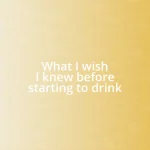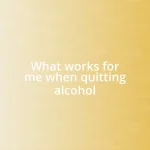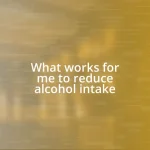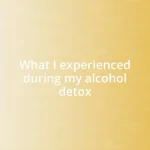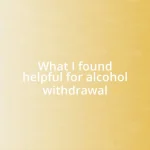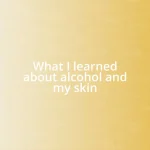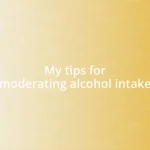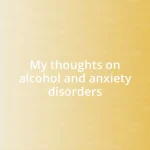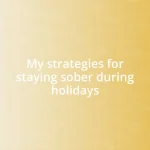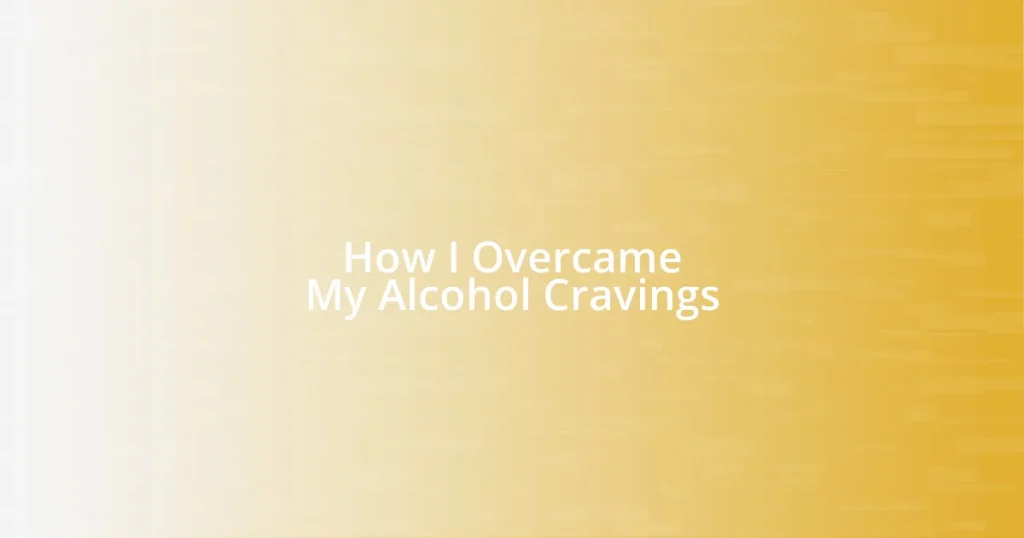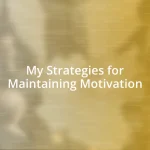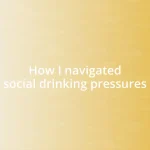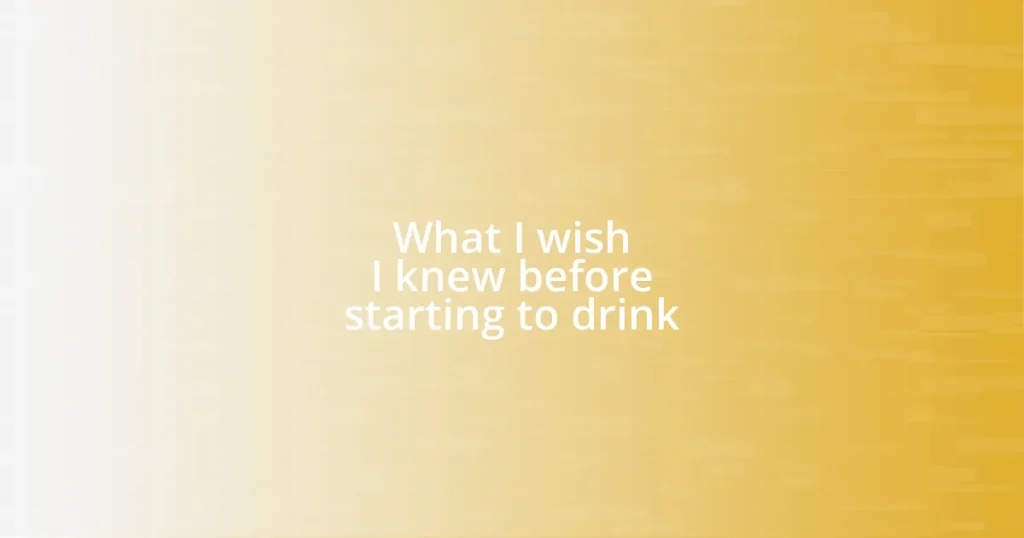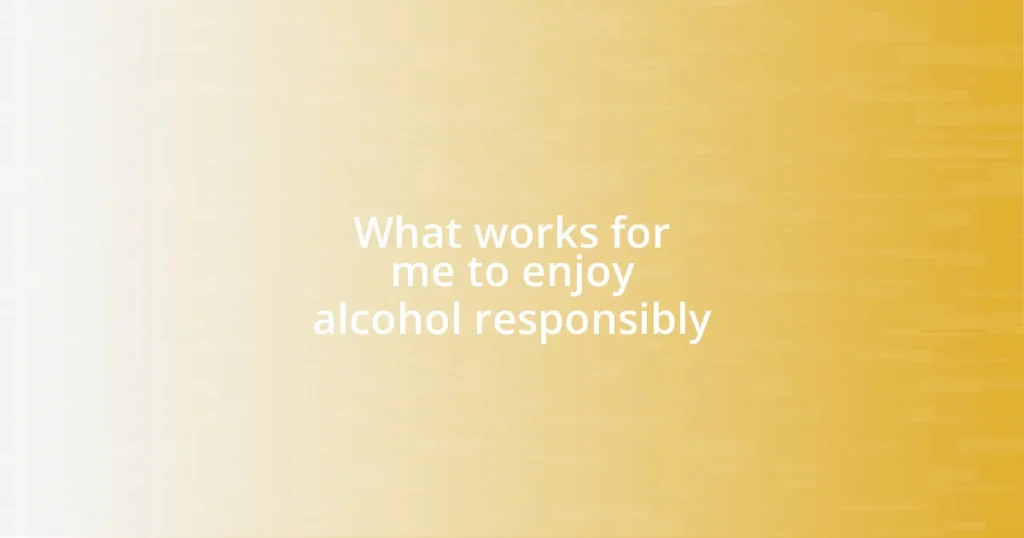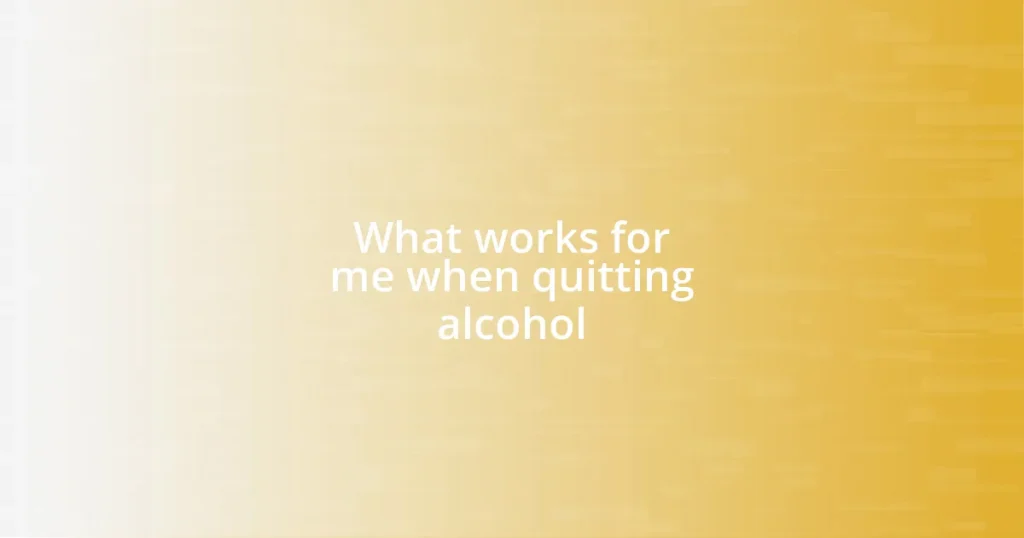Key takeaways:
- Understanding cravings involves recognizing emotional and physical triggers, such as stress, social situations, and environmental cues.
- Effective strategies for managing cravings include distraction, creating replacement habits, and building a supportive network.
- Mindfulness techniques like the “5-4-3-2-1” exercise and mindful journaling can help ground oneself during craving episodes.
- Celebrating sobriety milestones reinforces progress and fosters a sense of community and accountability in recovery.

Understanding Alcohol Cravings
Understanding alcohol cravings can be quite a journey. I remember staring at a glass of wine at a friend’s party, feeling a tug in my chest that was all too familiar. It’s fascinating how our minds can link such strong emotions to a simple drink, isn’t it?
At the core of these cravings lies a complex interplay of emotional and physical triggers. For me, stress often brought about a desire to reach for a drink, as if it could magically dissolve my worries. I’ve often wondered—how many of us use alcohol as a way to cope, thinking it will provide relief, only to find we’re left wanting more?
Understanding this urges us to reflect on our habits. I’ve found that recognizing my cravings when they hit can sometimes diffuse their power. When I consciously acknowledge that feeling, I can ask myself what I really need in that moment—comfort, distraction, or maybe even just a good chat with a friend. Have you ever paused to consider what your cravings truly signify?

Identifying Triggers for Cravings
Identifying triggers for cravings can be incredibly enlightening. I’ll never forget one evening when I was feeling overwhelmed after a hectic week. I walked past the liquor aisle at the store, and my mind raced with thoughts of a cold beer, not just for the flavor, but as a reward for my hard work. That moment made me realize how deep-rooted my triggers were—stress, routine, and even social cues played a significant role in my cravings.
It’s essential to pinpoint these triggers. Here’s a list of common ones that I’ve found helpful in my journey:
- Stress: Feeling overwhelmed by work or personal life.
- Social Situations: Parties or gatherings where alcohol is prevalent.
- Routine: Familiar habits associated with drinking, like winding down at the end of the day.
- Emotional Moments: Celebrations, loneliness, or sadness that prompt the desire to drink.
- Environmental Cues: Specific places or sounds that remind me of drinking, such as bars or certain songs.
Reflecting on these triggers opens up a path to handle them more effectively. I often remind myself that recognizing the cue is the first step toward empowering myself to make a different choice.

Strategies to Manage Cravings
Managing cravings is all about having the right tools in your toolkit. One approach that worked wonders for me was distraction. Instead of succumbing to cravings, I learned to immerse myself in activities that typically bring me joy—like hiking or diving into a good book. These moments not only proved to be fulfilling but also served as a reminder that life could be satisfying without alcohol.
Another strategy that I found beneficial was creating a replacement habit. Whenever I felt an urge for a drink, I would opt for a sparkling water with a slice of lime instead. This little tweak helped me savor something refreshing while breaking the association between relaxation and alcohol. Over time, I even started to look forward to my “mocktail hour,” where I could enjoy bubbly drinks without the buzz.
Lastly, forming a support network has been crucial. I’ve connected with friends who understand my journey, and we often share our experiences when cravings hit. Talking about the feelings behind those cravings—to those who get it—has created a sense of accountability and relief. It reminds me that I’m not alone and that we’re all navigating similar waters.
| Strategy | Description |
|---|---|
| Distraction | Engaging in enjoyable activities, like hiking or reading, to shift focus away from cravings. |
| Replacement Habit | Choosing non-alcoholic options, such as sparkling water, to satisfy the desire for a drink. |
| Support Network | Connecting with friends or support groups to share experiences and feelings about cravings. |

The Role of Support Systems
One of the most transformative aspects of my journey has been the support I found in others. I remember attending a small group meeting for people facing similar struggles. Hearing stories from others made me realize that I wasn’t on this tough path alone, reminding me that it’s perfectly okay to lean on others for help. Have you ever felt that sense of camaraderie? It’s truly uplifting.
Support systems can take many forms. For me, my closest friends became my lifeline. They were always ready to listen, whether it was a moment of weakness or a small victory. I still recall a late-night phone call when I was feeling particularly vulnerable. Just talking through my cravings opened a floodgate of emotions, helping me process what I was going through. I often wonder how different my experience would have been without that outlet.
Incorporating support into my daily routine has also proved invaluable. Simply reaching out to someone before I faced a potential trigger has become a new habit. I started sharing my plans for weekends, like which events I’d avoid or how I would navigate social situations. This accountability kept me grounded and focused, making it less likely for cravings to take the wheel. Do you have someone in your life who can help keep you accountable? I can’t stress enough how much these connections can bolster your resolve.

Mindfulness Techniques for Craving Control
Practicing mindfulness has been a game-changer in managing my alcohol cravings. I’ve developed a habit of taking a few minutes each day to focus on my breath and acknowledge my feelings without judgment. When cravings hit, I find that just sitting quietly and tuning into my body helps demystify the urge, allowing me to see it as a fleeting thought rather than an irresistible impulse. Have you tried this? It can be surprisingly liberating.
I also learned to use grounding techniques, especially when those sudden cravings would spike. One method I found effective is the “5-4-3-2-1” exercise, which helps to center my thoughts. I identify five things I can see, four I can touch, three I can hear, two I can smell, and one I can taste. This sensory awareness shifts my focus away from the craving and back to the present moment. Honestly, it’s amazing how quickly this technique can ground me and make the craving feel less overwhelming.
Another technique that proved invaluable is mindful journaling. Each time I felt the urge rising, I’d jot down my thoughts and feelings on paper. This practice not only helps me recognize patterns in my cravings but also gives me a safe space to express my emotions. Reflecting on these moments later has been enlightening, almost like having a conversation with my past self. Have you considered keeping a journal? It’s a beautiful, introspective way to untangle those complicated feelings that accompany cravings.

Building Healthy Habits for Recovery
Building healthy habits has been crucial in my recovery journey. I still remember the early days when I felt completely lost, unsure of what to focus on. That’s when I started establishing a daily routine, which provided me with a sense of structure and purpose. Adding in small, healthy activities—like a morning walk or preparing a nutritious breakfast—helped me redirect my energy towards something positive. Have you found that little routines can influence your day significantly? In my case, they were game-changers.
Staying physically active became another cornerstone of my recovery. I used to think that going to the gym was just about lifting weights, but I discovered that exercising could also serve as a powerful emotional outlet. Each time I jogged or participated in a yoga class, I felt a weight lifting off my shoulders. Those moments of physical exertion released endorphins that made me feel genuinely happy and alive. Can you recall a time when a simple walk changed your perspective? For me, it was a reminder that I could feel good without resorting to alcohol.
Developing skills for self-soothing has been equally transformative. I often struggled with overwhelming emotions, and finding healthier alternatives was essential. There was one evening when I felt the urge pulling at me intensely. Instead of reaching for a drink, I decided to immerse myself in a good book. Losing myself in a different world was surprisingly effective, and I didn’t just read—I felt every word resonate deeply. Do you have ways to nurture yourself when you’re feeling vulnerable? For me, building these habits created a toolbox of coping strategies that reinforced my journey to sobriety.

Celebrating Milestones in Sobriety
Celebrating milestones in sobriety has become one of my favorite parts of this journey. Each sober day earned feels like a tiny victory that deserves recognition. Just a few months in, I decided to treat myself to a special meal at my favorite restaurant. Interestingly, it felt like more than just a dinner; it marked my commitment to a healthier, alcohol-free lifestyle. Have you ever recognized a moment that shifted your perspective on your progress? I’ve realized that these milestones are not just markers in time; they are affirmations of the hard work put into changing my life.
I remember hitting my first month of sobriety and throwing myself a small celebration with friends who supported my decision. We gathered for a game night, complete with non-alcoholic drinks and lots of laughter. I can still hear the sound of our joy echoing through the room. Reflecting on that night fills me with gratitude. Celebrating my milestones reinforced my sense of community and reminded me that I wasn’t alone on this path. Have you surrounded yourself with positive influences on your journey? I truly believe that shared moments of joy propel us forward, making the commitment to sobriety even more rewarding.
Looking back at my progress, it’s fascinating how those milestones have shaped my journey. I’ve begun creating a visual representation of my sobriety, like a feel-good wall where I post cards and mementos from my achievements. There’s something incredibly uplifting about seeing those reminders each day. Doesn’t it feel empowering to look at tangible proof of growth and change? Every time I glance at those reminders, it reinforces my commitment and inspires me to keep moving forward, knowing how far I’ve come.
